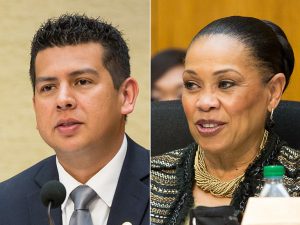 For the second time in two years, a solid Democratic majority on the San Diego City Council could not agree on choosing a Council President, so the Republican minority again orchestrated the selection of their council leader.
For the second time in two years, a solid Democratic majority on the San Diego City Council could not agree on choosing a Council President, so the Republican minority again orchestrated the selection of their council leader.
This week, Councilwoman Myrtle Cole was selected to serve as the Council President, a mostly ceremonial, but still important role in running San Diego’s city government. Cole, a Democrat, was vying for President against Councilman David Alvarez, also a Democrat. Alvarez was elected to the Council in 2010 and again in 2014, and Cole was elected in 2014.
This week they were joined by newly elected Democrats Chris Ward, Georgette Gomez, and Barbara Bry to form a new 5-4 Democratic majority. Republican members Mark Kersey, Scott Sherman, Lori Zapf, and Chris Cate also serve on the City Council.
But in selecting their President, the Democrats were divided between Cole and Alvarez and couldn’t hold together to agree on one. So Cole put together the four Republicans to support her, giving her the 5 votes needed to secure to post. Newcomer Barbara Bry joined in for an added vote to make the final count 6 to 3, with newly elected Councilmembers Gomez and Ward sticking with Alvarez.
Under the strong mayor form of government in San Diego, the Council President sets the docket for Council meetings, assigns committee chairmanships and membership, and could serve as Interim Mayor in the absence of the Mayor, as what happened in 2013 when then-Mayor Bob Filner resigned in a scandal.
Two years ago, the same scenario played out when Democrat Sherri Lightner got the support of four Republicans to oust Democrat Todd Gloria as Council President. Lightner was a more moderate candidate than Gloria.
For years, the City’s voter registration has turned more and more Democratic, and, in recent years, city election turnout has propelled Democrats into citywide positions, including 2004’s election of Mike Aguirre as City Attorney, and 2012’s election of Bob Filner as Mayor. The strong support of labor unions helped fund Democrats in races that only year’s earlier were very difficult for them to win.
In the 2013 special election to replace disgraced Mayor Bob Filner, Democrats and labor unions backed Councilman David Alvarez against then-Councilman Kevin Faulconer. Alvarez divided the Democratic vote with former Assemblyman Nathan Fletcher and former City Attorney Mike Aguirre. Faulconer and Alvarez went to a run-off election where Faulconer took 52% of the vote to become the new mayor.
In the 2016 election, Democrats couldn’t agree on a one of their own to challenge Faulconer for re-election. In the end, Faulconer cruised to an easy win in the primary election, besting former Democrat Lori Saldaña and little-known Democrat Ed Harris.
Democrat’s weak performance in the Mayor’s race gives Faulconer an air of invulnerability. The strong form of government gives him greater control over the City’s direction. The balance to the Mayor should be a unified Democratic majority to promote more progressive agenda items, including plans to address affordable housing, homelessness, and responsible community development.
By failing to reach a united agreement on their choice for Council President, the Democrats put the Republicans, and therefore, the Mayor, back in control without a valid check on his power.
The clash for Council President not only showed a divide among the Democrats on the Council, but also among their labor union backers. The San Diego Labor Council, made up of 130 local unions, backed Cole, while the San Diego Building and Construction Trades Council backed Alvarez. One of the largest unions in San Diego, the grocery stores’ United Food and Commercial Workers (UFCW), also backed Cole. That union was a big backer of Alvarez just three years ago when he ran for Mayor.
After years of working to gain a majority, Democrats have failed to reap the full benefit of their hard-fought gains. Although voters around the City have elected more Democrats than Republicans to the Council, effective control still seems to rest to the right on the political spectrum.
The upshot is that, for the first time in San Diego’s history, the San Diego City Council is majority minority. With new councilmembers Gomez and Ward, the majority of the Council is now made up of Latinos, an African-American woman, and LGBT candidates.
San Diego has changed, and the Council is reflecting the new demographics.
We hope this Council will find ways to work together to continue the progress we’ve made to better the lives of all residents.
Category